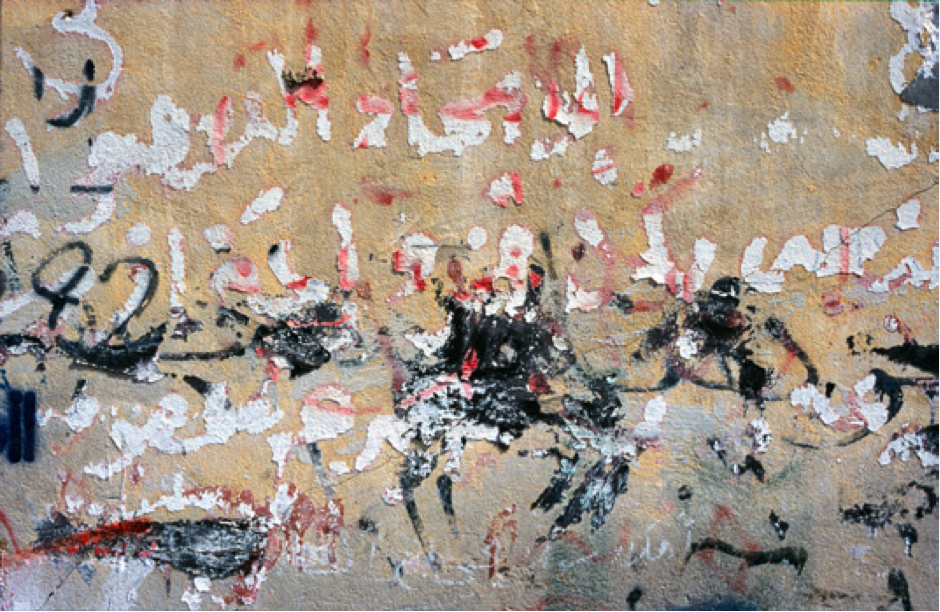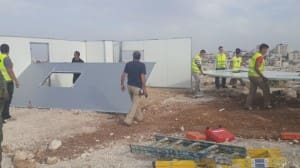This article first appeared in Jadiliyya.
There were an impressive number of Palestinians at the May 19 opening in Ramallah of Keep Your Eye on the Wall, a photographic exhibit. “The Wall” (aka Apartheid Wall, Separation Wall, Security Fence, Barrier) is such an omnipresent feature of Palestinians’ lives, it is surprising they would voluntarily choose to look at photographs of it. But they did, and many seemed entranced by the large artistic images.
“The striking visual impact is critical,” explained Olivia Snaije who conceptualized the project along with Mitchell Albert in order to raise awareness internationally. “Because even people who have heard about The Wall through the media don’t realize the meanings it has for Palestinians, beyond the obvious physicality of it.”
Snaije maintained that exhibiting the photos in Palestine is also important. She mentioned one Palestinian who told her that he had become used to The Wall and had accommodated himself to the many hardships it causes. The exhibit, which includes commissioned photographs that stun, engage and provoke, reminds international people and Palestinians alike that The Wall is not normal.
Only two photographers were present at the opening in Ramallah—Palestinian Rula Halawani and Kai Wiedenhöfer, who is German. Raeda Saadeh and Steve Sabella were unavailable, and Taysir Batniji was prevented from coming by Israeli restrictions.
“Of course I would have come,” said Batniji from his residence in France. His last visit to Ramallah was in 2000, and prior to that, 1992. Batniji explained that although he has a French passport, Israel treats him as a Palestinian from Gaza when he tries to cross a border. “It’s very complicated for me to travel, whether to Gaza or Ramallah. It would have required a great deal of diplomatic intervention.”
Curators of the traveling exhibit, Mónica Santos and Sandra Maunac (Masasam), say that each show is displayed differently in response to the unique opportunities and constraints of the venue. In Ramallah, their care was apparent in the ingenious use of a small alcove with three walls located at the entry to the exhibit hall. Batniji’s photographs, taken of Gaza walls in 2001, are displayed adjacent to one another in row upon row across the three walls of the alcove. In this way, Batniji’s photos themselves constitute bricks in a wall of images of walls. Observers stand surrounded on three sides, simulating the sense of confinement that Palestinians feel on a daily basis.

Batniji said he was interested in the walls in their manifestation as a tool of communication and community support: “The walls are a kind of journal on which people express their thoughts and positions.” He focused on posters announcing the death of martyrs. Of his photos, Batniji said: “These death notices formed a succession of faces that were soon erased, worn away by time, covered over, or torn off deliberately. The uncertain status of these images is what interested me. They were complex, formal, symbolic, and profoundly linked to questions of identity. This series reflects on a double disappearance: of those who gained “recognition” through their images on posters, and of the disappearance of the posters themselves.”
A review of the book upon which the exhibit is based suggests that Keep Your Eye on the Wall risks romanticizing The Wall, but that it is a risk worth taking in order to “make fresh metaphorical connections.”
One such connection is the serendipitous timing of the Ramallah opening, just four days after the sixty-sixth commemoration of the Palestinian Nakba. Batniji agreed: “The Nakba is not a sequence of history that starts at one point and finishes. The Nakba continues, including by making it impossible for people to move freely to and from Palestine and between the West Bank and Gaza.”
Two boys were killed by Israeli live fire at this year’s Nakba protests in Ramallah. Their photographs are now plastered on walls around Ramallah. Soon, the elements will wear their faces away or they will be plastered over by new martyr posters. Sadly, Taysir Batniji is not here to photograph their photographs, to honor in art the lives of these boys who gained notoriety only in death.
But like most Palestinian art, Batniji draws not only on metaphors of death and disappearance, but also on metaphors of resistance. Batniji’s photos of The Wall entered Ramallah though Batniji himself could not. He said: “Although I cannot physically attend the exhibition, my work is there and it’s a way to break the siege that’s imposed on Palestinians and push back against the repression of communication in the space.
The exhibit runs through June 20 at the French-German Cultural Center.
